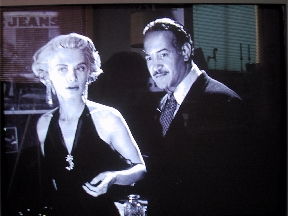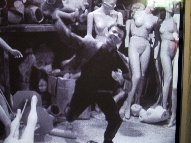Killer's Kiss (1955) United Artists dir. Stanley Kubrick writ. Howard O. Sackler (uncredited) from the story by Kubrick cine Stanley Kubrick edt Kubrick music Gerald Fried star Frank Silvera (Rapello), Jamie Smith (Davey), Irene Kane (Gloria)... with Ruth Sobotka, Alex Rubin, David Vaughan et. al.
from the Museum of Black and White
Do we dream in black and white, or in color? Just as some aesthetes believe silent film is the only cinematic form, even more believe black and white photography is the only true expression of art. The simplicity of a semi-tone universe where space collapses into two dimensions and the material world is rendered in mystifications of light and shadow is not only appealing but is also the way we remember the Industrial Age. Black and white is a marker of history, geometry and technology, dream and depression. The alienation of 20th Century Man is seen in the solitude of his rectilinear environment, a fascism of vertical and horizontal lines whose machine precision exists in order to help him sleep better.
Consider the young boxer in Kubrick's Killer's Kiss: as he lies down on a small bed in a small apartment somewhere in New York, his rest is interrupted by a fracas in another flat in an adjacent wing. He hears a scream, looks through the window, sees a man struggling with a beautiful young woman -- another kind of "fight" from the one he just lost a few hours ago in the ring. His loneliness is a frame for dream and reality. Sex is always a triangular relationship -- soon he finds himself fighting not only for money but also for love.
His dream is developed as a "negative" print in anticipation of his fate. Is he being pursued or is he pursuing? The onrushing imagery is spectral and fearful, the camera moving like a speeding ambulance down a narrow street between tall buildings that exist only as bone shadows. This simple photographic trick is like an X-ray of the soul.
The rectilinearity isn't confined merely to shadow and light. The characters exist in boxes, like forgotten animals. The Spartan apartments where Gloria and Davey live are boxes. The dancehall where Gloria works as a dance mannikin is a box. Rapello's office is a box, a gloomy den where he watches TV and runs his dancehall. The gym where Davey trains is a box... and the ring where he fights (and loses) is a box. When pursued by Rapello's thugs, he finds himself trapped in a box canyon formed by the drab, abandoned warehouses. In fact, the narrative frame sees Davey "boxed", pacing back and forth in the stone and steel vault of the railroad station as he waits to escape the city with his new love, Gloria.

While the cinematic execution is often self-conscious, this pulp film noir has the contradictory beauty of a fresh cigarette in a fresh mouth. Gloria (Irene Kane) glitters like a silver doll, almost luminous (which makes you realize that the period craze for blonds was probably due to their photogenic allure in the black and white medium) in the shabby world around her. While the influence of the neo-realist films by Vittorio de Sica is strong, occasional inserts such as the ballerina dancing alone give the action a charming expressionism and psychological inscape. These inventions are a means of dealing with unsynced dialogue... and the ballerina sequence a chance for Kubrick to showcase his then current wife, Ruth Sobotka.
While the plot has the lurid simplicity of a Latino comic book melodrama -- an impression due in part to the occasional Latin soundtrack rhythms and villain called "Rapello" -- Kubrick works the two-dimensionality of the tableaux to artistic advantage. Single camera, single spot lighting, single frame transitions. The m.o. is that of a gallery photographer.
It's easy to forget that Kubrick emerged from the Museum of Black and White, that he shaped his world-view as a Leicaflex stringer for Life Magazine before he ever made a movie.
There is one noticeable collapse in continuity: Rapello starts out driving a Cadillac convertible, but ends up driving a Plymouth convertible. He drives away from his dancehall at night, but arrives at his warehouse prison during daylight. Davey follows in a taxi. They must've circled New York, sold the Caddy to pay for the cab and downsize to the Plymouth, or scenes are missing. More likely, Kubrick ran out of money.
Although the imagery has become cliche now, the scene where Davey
and Rapello have their showdown in the mannikin factory is fabulous. These
industrial sculptures of the human female form act as an inhuman cyclorama to
the primal combat of the Industrial Men. As Davey and Rapello thrash around
among the mannikin torsos, this abstraction of misogyny and male despair
becomes the perfect statement of civilization. To fight over a woman is as
basic as it is biological... but to fight with these dismembered female totems
as an audience is as exquisite as it is existential. Expressionist theatre,
modernist art, the eroticism is in the symbol rather than the flesh.

So is this why we like black and white photography? Because it symbolizes rather than renders reality? Within its binary cage, it becomes pure imagination, the geometrics of light and shadow, good and evil, the model of a planned universe. Whether through a hole in the clouds or a venetian blind, shadow gives shape to light... and human folly becomes art.
As a film, perhaps Killer's Kiss suffers from its derivative situations and consequently a derivative period morality. Between Hitchcock and de Sica, the comic book and the art gallery, Kubrick somehow manages to assert his own personal style. We see all his primary obsessions here, including the beautiful dancing woman and the perplexed, dueling man.
© LR 2/2000